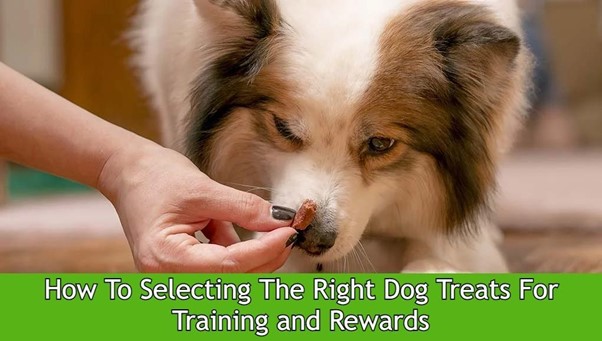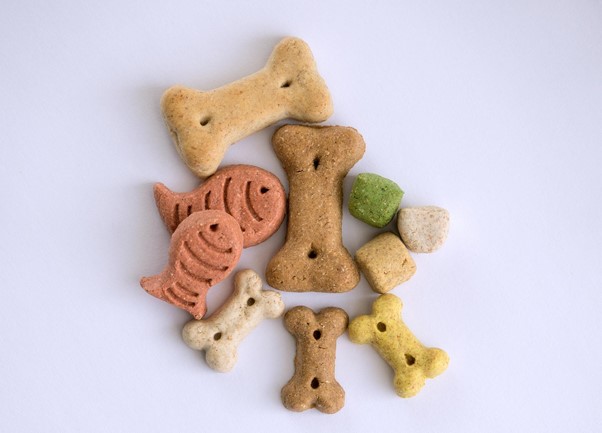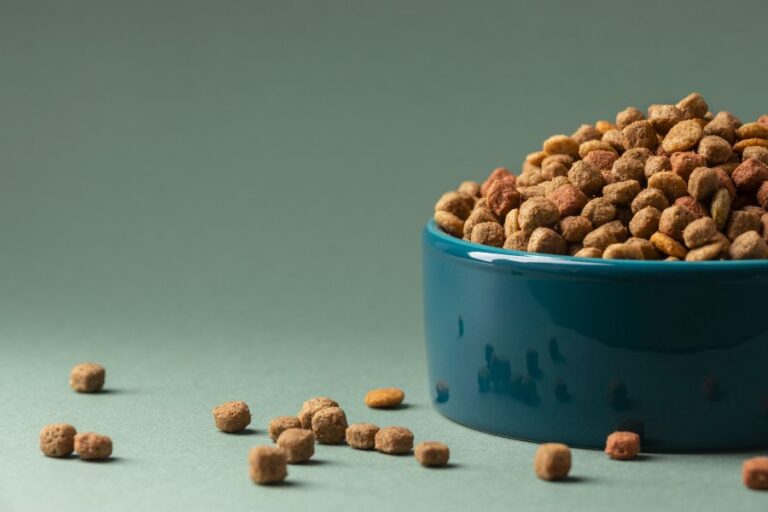The Ultimate Guide To Selecting The Right Dog Treats for Training and Rewards
- Last updated on April 7, 2023
- By: Caroline Stowe
Training your dog can be a challenging but rewarding experience. One way to help make the process easier is by using treats as rewards or trainers during the training process.
Not only do these tasty snacks motivate your pup, but treats can also help create a positive and lasting bond between you and your dog.
In this blog post, we will discuss everything that you need to learn about dog treats and how they are beneficial in training and rewarding your dog.

Why Use Treats for Training and Rewards?
Using treats for training and rewards is a great way to help make the process of teaching your dog new behaviors easier and more enjoyable.
Treats can be used to reward good behavior, motivate during long training sessions, or as a distraction when introducing your pup to something new.
In addition to being an effective tool for dog training, treats can also serve as a great way to bond with and show your love for your pup.
Types Of Dog Treats To Use For Rewarding Good Behavior
When it comes to choosing treats for training and rewards, there are a variety of options available on the market today. Here are some of the most popular types of treats for training and rewards:
Liver Treats
Liver treats are a favorite among many dogs because of their intense flavor.
They’re also relatively cheap and easy to find in pet stores. However, they should only be used in moderation as they can be high in fat and calories.
Cheese
Who doesn’t love cheese? Most dogs go crazy for the stuff, and it’s a great way to reward them for good behavior.
Just be sure to choose a cheese that’s low in fat and sodium, like mozzarella or cottage cheese.
Peanut Butter
Peanut butter is another favorite treat among dogs (and humans!). It’s a good source of protein and healthy fats, and it’s also relatively inexpensive.
Just be sure to choose a peanut butter that doesn’t contain xylitol, which is toxic to dogs.
Salmon Treats
Salmon treats are a great option for dogs who are picky eaters or have allergies to other types of meat.
They’re also rich in omega-3 fatty acids, which have numerous health benefits for both dogs and humans.
Chicken
Chicken is another good option for dogs who are picky eaters or have allergies.
It’s also a lean protein source, so it’s lower in calories and fat than some other options on this list.
Yogurt
Yogurt is a great source of calcium and protein, and it can also help settle your dog’s stomach if they ate something that didn’t agree with them.
Just be sure to choose a yogurt that doesn’t contain artificial sweeteners like xylitol, which is toxic to dogs.
Vegetables
Yes, believe it or not, some dogs actually like vegetables! If your dog is one of them, then consider using sweet potato, carrots, green beans, or broccoli as training treats. Not only are they healthy, but they’re also low in calories.
Fruit
Fruit is another healthy treat option for dogs who enjoy the taste of sweet things. Some popular fruit options include apples, bananas, blueberries, and watermelon (seeds removed).
Just be sure not to give your dog too much fruit as it can cause digestive problems due to the natural sugar content.
Dog Biscuits
Dog biscuits are the classic treat choice for many dog owners, and there’s a reason why they come in all different shapes, sizes, and flavors so you can find the perfect one for your pup!
Plus, they usually contain all-natural ingredients with no artificial flavors or preservatives.
Benefits of Using Natural Ingredients in Dog Treats
It’s important to make sure your dog’s treats are made with natural ingredients that provide essential nutrients for their overall well-being.
Let’s take a look at the benefits of using natural ingredients in dog treats.
Increased Nutritional Value
Natural ingredients contain the vitamins, minerals, and proteins that are essential for optimal health in dogs.
These nutrients can help keep your pup fit and energetic, providing them with the energy they need to stay active and playful throughout the day without feeling sluggish or lethargic.
Better Digestion
Since natural dog treats are made with whole foods, they can be easier on your pup’s digestive system and help them process their food more efficiently.
This can reduce stomach discomfort, gas, and constipation while improving nutrient absorption so your pup gets the most out of every bite!
Healthier Skin and Coat
Natural ingredients are often rich in omega-3 fatty acids which can promote healthy skin and coat development in dogs as well as joint health.
Omega-3 fatty acids also have anti-inflammatory properties that can help reduce itching and flakiness associated with certain skin conditions like allergies or dermatitis.

Improved Oral Health
Natural dog treats contain fiber which helps clean off plaque from teeth while promoting better oral hygiene overall. This can help prevent tartar buildup which could lead to tooth decay or gum disease if left untreated for too long!
Plus, chewing on crunchy treats can exercise your pup’s jaw muscles for stronger teeth over time too!
Support Sustainable Farming Practices
By choosing natural pet food products you are helping support sustainable farming practices that benefit both animals and the environment alike!
Not only will this make a difference now but it will also ensure a healthier future for generations to come!
Nutritional Considerations When Choosing a Reward or Training Treat
There are so many options out there, but it’s important to choose treats that provide nutritional value and won’t harm your pup in the long run.
Let’s take a look at some of the things you should consider when selecting dog treats for training and rewards.
Ingredients
The first thing to pay attention to is the ingredients list on any dog treat you plan to buy. It’s important to make sure that the treat is made using natural ingredients with no artificial preservatives, colors, flavors, or sweeteners.
Look for whole food ingredients like real meat or fruit that provide protein and other essential vitamins and minerals necessary for good health in dogs.
Avoid products that contain fillers like corn syrup or wheat gluten as they can upset your pup’s stomach or cause allergies.
Calories
When choosing healthy treats for your pup, it’s important not to overdo it on calories! Many people mistakenly think that giving their pup lots of treats is a sign of love and affection but too many calories can lead to obesity in dogs just like in humans.
Be mindful of how many calories each treat contains and how many treats your pup should get based on their size and activity level.
You want to make sure they get enough nutrition without overdoing it!
Taste
Just because something is good for your pup doesn’t mean they’ll enjoy eating it! This is why it’s important not only to look at the nutritional content of a treat but also its flavor profile.
Look for high-quality products with natural flavors like real meat or fish that will appeal to your pup’s taste buds and make them excited about getting their reward!

How To Choose the Right Size, Flavor & Texture of Dogs Treats
Depending on the size, flavor, and texture of the treat, your dog may love it or hate it.
To ensure that you get a treat that is just right for your four-legged friend, here are some tips to help you make an informed decision.
Size Matters
No matter what type of treatment you choose, size matters when it comes to selecting one for your pup. You will want to choose a treat that is appropriate for the size of your dog.
For small breeds like Chihuahuas or Pomeranians, opt for smaller treats that won’t take too long to chew and swallow. For larger breeds like Labrador Retrievers or German Shepherds, larger treats are more appropriate since they can handle them better.
If you’re not sure what size is best for your pup, ask your vet or consult with a pet nutritionist who can help you pick the right one.
Flavor Profile
When it comes to flavor profiles, there are two main categories, people’s food flavors and animal flavors.
People’s food flavors typically include things like bacon, beef, chicken, and turkey while animal flavors often include things like salmon and duck.
In general, most dogs prefer people’s food flavors over animal ones because they tend to taste better in their mouths due to their higher fat content.
However, some dogs may have allergies or sensitivities to certain types of meats so always check with your vet before giving them any new treats.
Texture & Consistency
The texture and consistency of a dog treat are also important when it comes to making sure that it’s safe for them to eat. Generally speaking, softer treats are best because they’re easier for dogs to chew and digest without any issues or discomfort.
Harder treats may pose a choking hazard if they’re too big or hard for your pup’s teeth so make sure that you pick something age-appropriate and easy enough for them to chew safely.
Additionally, avoid anything with sharp edges as these can cause injury in some cases if swallowed whole by accident.
Step-by-Step Guide on Making Homemade Dog Treats as Rewards
If you’re looking for an easy and cost-effective way to provide your furry friend with something special, making homemade dog treats is the way to go!
These treats are sure to be a hit with your pup, and this step-by-step guide will get you started.
Ingredients & Supplies
The first step in making homemade dog treats is gathering ingredients and supplies. For most recipes, you’ll need some type of flour (whole wheat, oat, etc.), vegetable oil, eggs, and water.
You should also have a baking sheet or two on hand as well as an oven preheated to 350 degrees Fahrenheit.
Plus, feel free to get creative and add any other ingredients your pup loves such as peanut butter or honey!
Mix & Measure
Once you have all of your ingredients ready to go, it’s time to mix them up! Depending on the recipe you choose, you may need a mixer or just a bowl and spoon.
Either way, be sure that all of the ingredients are thoroughly combined before pouring them onto the baking sheets.
Use a teaspoon or tablespoon, depending on the size of the treats you want to measure out each one before placing it onto the baking sheet.
Bake & Cool
Place the baking sheets into the preheated oven for about 15 minutes or however long is recommended by the recipe instructions and then remove them from the oven once they are nice and golden brown.
Once they have cooled completely, store them in an airtight container and place them in either your pantry or refrigerator depending on how quickly you plan on using them!

Benefits of Treats For Training and Rewards
Treats are an excellent way to reward good behavior and encourage learning. Here are a few benefits of using dog treats for training and rewards.
The Power of Positive Reinforcement
Positive reinforcement is one of the most effective methods of teaching a dog new behaviors or commands.
When you give your dog a treat as a reward for good behavior, it reinforces their understanding that following your instructions will please them.
This is especially true for puppies, who need to learn quickly to make positive associations with commands and behaviors.
Building Trust
Treats are also a great way to build trust between you and your pup.
When they receive treats as rewards for their efforts, they learn that you can be trusted to provide them with something pleasurable when they do what you ask of them.
This helps establish trust in the relationship between pet and owner, which makes training much more effective.
Encourages Problem-Solving Skills
Dog treats can also help encourage problem-solving skills in dogs by providing them with an incentive to figure out how to complete tasks on their own.
For example, if you hide treats around the house or yard and then tell your dog to “find it” or “seek” the treat, they have no choice but to use their problem-solving skills to locate it!
Giving them a tasty reward at the end encourages them even more!
Improves Bonding Time
Training sessions don’t just have to involve commands; they can also involve fun activities like playing games or going on walks together!
If playing games together is part of your normal bonding routine, utilizing treats as rewards can enhance the experience even further!
Treats help reinforce the bond between pet owners while encouraging physical activity and mental stimulation – two important aspects of any healthy lifestyle!
Tips For Making The Most Of Dog Treats for Training & Rewards
It’s important to know how to use treats effectively. Here are some tips for making the most of dog treats for training and rewards.
Use Positive Reinforcement
Positive reinforcement is one of the most effective methods for teaching your pup new behaviors.
When you reward them with a treat for good behavior, they understand that this behavior is what you want from them.
This will help encourage your pup to continue displaying good behavior to get more treats.

Keep Treats Small
It’s important to keep treat sizes small when training or rewarding your pup so they don’t fill up too quickly and lose interest in the activity at hand.
If you find that your pup is no longer interested in their treats, try switching up the type or flavor of treat you give them.
Use High-Value Treats
Using high-value treats can help motivate your pup to learn new behaviors faster because they are more likely to do whatever it takes to get their desired reward.
High-value treats can include anything from cheese cubes or hot dogs, but be sure not to overdo it as too many high-fat content treats can cause health issues later on down the line for your pup!
Train With Food Puzzles
Food puzzles are an excellent way to engage your pup mentally while also providing them with a tasty reward after completing the puzzle successfully!
Not only will this challenge their problem-solving skills, but it also provides an opportunity for quality bonding time between you and your pup as well!
Reward Good Behavior Immediately
It’s important that when you see your pup performing desired behaviors, such as sitting or staying, you reward them immediately with a treat so they know what behavior was rewarded and why!
This will help reinforce positive behaviors and ensure that those behaviors continue in the future as well!
Conclusion
Using treats as rewards for your pup’s efforts is an effective way to build trust, encourage problem-solving skills, and improve bonding time.
With the tips provided in this article, you can make sure that you are using dog treats effectively when training or rewarding your pup.
Not only will this help reinforce desired behaviors but it also provides a fun opportunity for quality bonding between pet owner and pup!
By leveraging these cognitive neuroscience principles with food puzzles, high-value treats, and positive reinforcement techniques, you can ensure that each of your training sessions is successful while building a strong bond with your beloved four-legged friend.
Avoid the common mistakes when giving dog treats while training by clicking the link below.
-
Author: Caroline Stowe
- Updated on April 7, 2023
Disclaimer: This article doesn’t intend to replace professional veterinary advice, nor should it be used as a substitute for veterinary services, diagnosis, or treatment. The content on this website, including information and opinions expressed herein, are intended for general informational purposes only. In case you have concerns or questions regarding your dog’s health and diet requirements, please consult your veterinarian before doing anything that might affect it.
DogPetGuide.com and the writer are not responsible or liable for any damage, liability, costs, or claims arising from any possible consequences of the reader’s action after reading this article.




